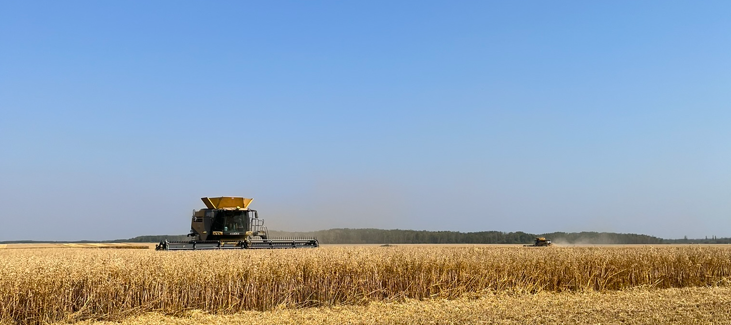

Oilseed Highlights
- Monday and Tuesdays trade relatively lackluster for the oilseeds. Some gains made in Canola to get above the $600 per tonne mark again after looking it late last week.
- Some recovery in Palm oil and other comparison veg oil products kept Canola alive.
- Markets need to see some stronger demand to get fired back up. USDA posted some good soybean export figures after 2 straight weeks of exports below estimates
- Canola exports need to start showing some life for markets to take the crop seriously.
- Chinese New Year is Saturday, February 10th
- Big report week as Statistics Canada is out with the Stocks of Principal Field Crops report on Thursday.
- USDA WASDE and FAS reports are also out on Thursday which will give the markets some new trade fodder.
- A few more private analysts have been cutting Brazil’s soybean crop to under 150mmt. USDA sits at 157 mmt.
- Markets will want to see a USDA cut to the South American crop.
- Brazil around 16% harvested.
- Argentina’s crop is in critical pod filling stage
- Crop conditions reduced to 36% Good to Excellent. Down from 44% last week
- Soybeans were sold to a US crusher last week, the crusher was reportedly on the east coast of the US so the arbitrage was simply based off of land vs ocean freight and ocean freight often is far cheaper. Although not commonplace, these arbitrage opportunities do happen.
- Reports that China has been asking producers to reduce their Hog capacity due to slumping margins
- Shipping logistics playing a big part of old crop movement, US Gulf soybeans needing to skip the Panama Canal route and loosing some freight advantages to Brazil
- Houthi attacks in the Red Sea are disrupting shipping routes from key areas. One of most note would be EU or Black Sea shipments may need to reroute and take a longer trip through the Mediterranean. This also affects Australian logistics into middle eastern regions and EU as well
- Tensions rising in Middle East over recent attacks on US soldiers located in Jordan. US blaming Iran for the attacks.
- January 2024 USDA REPORT Below:
- US Winter Wheat plantings came in down 6% year over year and below what the trade was estimating. 1.4 million acres below expectations
- Brazilian soybean number was what everyone was watching. USDA put the figure at 157 mmt, higher than what the market wanted to see. Market was looking for a slightly smaller number but it still fell within most of the trade estimated range.
- Private estimates range from 140 to 151 mmt for the most part, while government agencies tend to be running a higher figure. CONAB on Wednesday published a 155 figure.
- The big bear of the report came from corn. 325mmt global carryout vs the 313mmt expectation. Some of the extra tonnage came simply from Chinese ending stocks climbing by 10 mmt.
- Often Chinese stocks are challenging to estimate and are separated out from the mix.
- For rapeseed (Canola), global ending stocks on rapeseed came in unchanged since report prior.
- Canadian exports were left untouched by the USDA and came in at 7.7 mmt
- We can see in our own calculated data that we are tracking below this figure and on pace for 6+ mmt.
- Canadian canola exports are being watched closely as we get closer to the halfway portion of the marketing year.
- CONAB (Brazil’s USDA) was out Early January
- The government agency put the crop at 155.3, down from 160.2 mmt in Decembers report.
- USDA Ag Atache in Brazil put its estimate at 158.5 mmt
- Brazil’s harvest has begun for soybeans and is all over the map, some inital yields were quite disappointing in the single digits for yields, but there are also some 40+ bushel crops out there.
- Canola sitting at record short position
- Below are the Latest Government Published Reports on Market Fundamentals
- Stats Canada(December Report:
- Canola- 18.3 mmt vs 18.3 mmt pre report estimate
- Spring Wheat – 24.7 mmt vs 24.0 mmt pre report estimate
- Barley 8.9 mmt vs 8.6 mmt pre report
- Oats 2.6 mmt vs 2.6 mmt pre report
- Durum 4.0 mmt vs 4.1 mmt pre report
- Corn 15.1 mmt vs 15.0 mmt pre report
- Soybeans 6.98 mmt
- Lentils 1.7 mmt vs 1.7 mmt pre report
- Peas 2.6 mmt vs 2.6 pre report
- Flax 0.272 vs 0.290 pre report
- For the Stats Canada report, most came in close to estimates and there was hardly anything that could be called a surprise in yesterdays release. Most of the production numbers are higher than they were in the early days of harvest when ideas for the canola crop were floating around a high 17’s number. Same could be said for Durum and a few other select crops.
- Stats Canada(December Report:
- ABARES AUSTRALIA REPORT HIGHLIGHTS (December Report):
- Canola estimated to come in at 5.5 mmt in the December 5th report. 5.2 was the figure in the pre harvest release in September.
- Barley estimated at 10.8 mmt vs 10.5 mmt in the September update
- Wheat estimated at 25.5 mmt vs 25.4 in the September update
- Neither the ABARES or Stats Canada provided any “scare” into the market for Canola or any other commodity as they all came in at or higher than anticipated.
- 4.7 to 5 mmt were private estimates for Australia heading into harvest, so it has risen from private estimates if anything.
- USDA AND CONAB ABOVE





USDA FAS




SOIL MOISTURE MAP – January 30th 2023 (1 Year Ago) – NASA GRACE



USDA FAS OILSEEDS
OILSEED TECHNICAL INDICATORS
CANOLA – BOLLINGER BANDS (18 Day Moving Average Red, 50 Day Black, 100 Day Yellow, 200 Day Green)

SOYBEAN OIL – BOLLINGER BANDS (18 Day Moving Average Red, 50 Day Black, 100 Day Yellow, 200 Day Green)

PALM OIL – BOLLINGER BANDS (18 Day Moving Average Red, 50 Day Black, 100 Day Yellow, 200 Day Green)

Special Crops


- North American Green Lentil acreage expected to grow in 2024 planting campaign, which could lead to heavier supplies.
- Indian winter crop looks alright as of now, harvest commencing within the coming weeks. Crop getting very close to maturity.
- Kazak Flax stocks look to be the lowest since 2017. Quality a slight concern as well. Canadian flax stocks will come in lower than the year prior, but not “tight” by any regards.
- A few more durum tenders expected to be posted this week of February 5th.
- It is expected Canada missed out on the latest Tunisian Durum Tender in at about $444 per tonne.
- Canada did some good business early January but there still is some global competition to work against
- Tunisia tendered for 50,000 tonne of Durum early January for around $446 US delivered. Canada expected to have picked up some of the business.
- Algeria also picked up some durum first full week of January for around the same price, it seems around 5-6 panamax ships worth was the figure being thrown around. Expected Canada will get some of this business as well.
- India playing the tariff game, extending the import tariff zero duty onto Lentils until March 2025
- Has yet to extend the veg oil import tariff reduction to Palm, Sun and Soy oils which is set to expire March 2024.
- Australian lentil crop 300,000 tonnes less than last year, but still one of the larger ones on record.
- Australia getting some good replenishing rains here in their summer season. Replenishing ahead of crop planting. Still a bit dry in Western Australia, a large canola production region.
- India pulled back import tariffs for peas from 50% to 0% until March 31st, 2024.
- Pea prices have fell in India post announcement as they were trending quite high leading up to announcement.
- The tariff removal is to allow more peas in before their new crop is harvested around March/April
- Peas need to be landed in India by March 31st, therefore need to leave exporting nation port in time to reach Indian shores. The tariff deadline cumulates with the Indian harvest cycle.
- Unclear yet if this will extend past March 31st cutoff date
- Chinese pea imports now over about half coming from Russia
- Russia has become more dominant in feeding China with peas and other crops. Once a market Canada dominated, market share has dropped significantly in the past 6 months
Crop Production Regions




Grains
- Grains suffer once again and sitting near pre 2020 levels in some cases.
- Corn vs Soybean acreage debate will become prominent throughout the end of February for US midwestern regions.
- Some anecdotal comments made recently were that the corn acres were fertilized already given the wide open fall. This will hinder the ability to swap acreage on those acres as it could hamper soybean production.
- As of January 29th, Kansas State Winter Wheat crop sits at 54% good to excellent. Crop was 33% in January 2023
- Chinese New Year celebrations this week and into the weekend. Tends to be a slower time of buying
- Feed grains / meal suffer globally as the prospect of a strong Chinese hog economy falters.
- Hog margins shrink in Asia
- Corn pricing into feed markets and is having some affect on other global feed grains such as barley.
- China opened its borders to Argentinian wheat late January, removing any trade barriers. Analysts unsure if any wheat of significant quantity will move into the region.
- US Midwest still has some dry areas but market not showing any concern yet.
- The largest surprise in the last few weeks likely came from the WASDE. The US corn belt was facing one of its largest dry streaks in years and yet national average corn yield came in at a all time record level.
- New USDA Report out on Thursday.
- Aside from South America, it tends to be a quieter time for grains themselves.
- Markets will look for any sort of story regarding demand this time of year.
- US winter wheat crop planted, Condition reporting becomes sporadic this time of year with some private and state level updates
- European winter wheat crop is in and dormant. There are a few areas of concern but still early in the winter.
- Still 2 months away from Spring wheat planting in North America.
- Look for reports on 2nd corn crop planting and progress from Brazil in the coming weeks. Some 2024 2nd crop is being planted right now.
- Indian fertilizer tender came out January 4th with results published on the 6th. Looks like $330 USD per ton was the figure released. Kind of in line with expectations and was not seen as a market moving event. Lower corn prices and the prospects of a smaller Brazilian corn crop has weighed on Nitrogen values as of recently.
- USDA posting lowest carryout of global wheat since 2015/16 in its latest World Agriculture Supply and Demand report.
- Stats Canada and ABARES both put out their reports first week of December and stated some larger than earlier anticipated wheat crops.
- Australian Wheat production to come in at 25.5 mmt, more than was forecasted in the September report but down 37% from last years massive harvest
- Australian Barley production to come in at 10.8 mmt, more than the September report but down 24% year over year as Australia took off a massive crop last year on Barley as well.
- Something of note: Russia has national elections March 2024, already being called a farce election as the Kremlin is handpicking opponents. Putin has announced he will run again for Presidential election
- China and Australia used to hold a major Barley trade prior to restrictions imposed in 2021.
- Canada is set loose some market share into China as it filled some of the missing gap from the Australian barley trade.
- January WASDE Summary
- US winter wheat plantings came in about 6% below last years plantings and also below traders anticipated levels.
- Corn was the big surprise, and a bearish one to boot. Global ending stocks jumped from 315.2 mmt to 325.2 mmt. Corn did not respond well post report as the news came in more bearish than anticipated.
- USDA did not touch South American corn new crop supplies. Brazils corn crop is essentially 100% planted as of report date for the first crop. Look for what market thinks of 2nd crop corn and general sentiment as we get closer to Fridays report.
- Eyes on the South American prospective crop. USDA sits at 129mmt (January report unchanged from December) while some privates sit in the 124-125 mmt range. The 2nd corn crop is the one to watch and it will be going in after bean harvest. So the sentiment of soil moisture as the beans begin to come off will be the large driver of this. For the time being, all eyes are on the bean crop, but 2nd crop corn will be next.
USDA FAS – GLOBAL GRAIN FOB WHEAT PRICES

Dalian Corn (China) – BOLLINGER BANDS (18 Day Moving Average Red, 50 Day Black, 100 Day Yellow)

Spring Wheat – BOLLINGER BANDS (18 Day Moving Average Red, 50 Day Black, 100 Day Yellow)

Chicago Wheat – BOLLINGER BANDS (18 Day Moving Average Red, 50 Day Black, 100 Day Yellow)

Corn – BOLLINGER BANDS (18 Day Moving Average Red, 50 Day Black, 100 Day Yellow)

South America (Argentina Bottom – Brazil Top) RAINFALL Precip Quantative – CPC 7 DAY QPF










